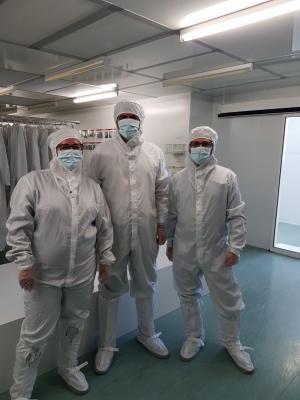 Israel-based Weebit Nano was established in 2014 with an aim to commercialize Rice University's SiOx RRAM technology. Weebit is progressing towards it stated goal of producing a 40nm RRAM Silicon Oxide working cell by the end of 2017.
Israel-based Weebit Nano was established in 2014 with an aim to commercialize Rice University's SiOx RRAM technology. Weebit is progressing towards it stated goal of producing a 40nm RRAM Silicon Oxide working cell by the end of 2017.
Coby Hanoch was recently appointed as the company's new CEO, and was kind enough to answer a few questions we had. Coby was VP Worldwide sales at Verisity where he was part of the founding team and grew the company to over $100M sales per year. He was also VP Worldwide sales at Jasper. Mr Hanoch holds a Bachelor of Science in Systems Design from Technion â Israel Institute of Technology.
Q: Coby, you recently joined Weebit as a CEO. What made you excited about Weebit's technology and business?
I believe Weebitâs technology has great potential, especially considering the fact that it is based on standard materials and tools, so once we finish the development we should be able to move more easily into production than other emerging memory technologies I have come across. In addition, and probably more important than the technology, a key driver to the success of a company is the team, and I was very impressed by Weebitâs team and the atmosphere in the company.
Q: What will be your main task as a CEO in the near future?
Weebit recently announced success in demonstrating a 4Kbit array in 300nm, and we are on track to meet our goal of 40nm working cells by the end of this year. While we still have significant challenges ahead of us, I believe it is time to start analyzing the different potential directions for the company. I will focus on meeting many people, including potential customers and partners as well as industry analysts and investors, so that I have a better knowledge of what the market needs are and how we can address them in the best way.

Q: You are collaborating with France's CEA/Leti institute, can you tell us about the nature of your agreement with Leti?
We have a great relationship with Leti, a true cooperation. Leti has very impressive state-of- the-art facilities and a team of experts in the ReRAM domain, which Weebit has the benefit of utilizing. Our teams are working closely to develop the technology, which includes Weebit engineering resources on site at Leti to enhance the collaboration.
 Weebit Nano's management team at Leti (Alla Felder - CFO, Coby Hanoch - CEO and Amir Regev, CTO)
Weebit Nano's management team at Leti (Alla Felder - CFO, Coby Hanoch - CEO and Amir Regev, CTO)
Q: What kind of applications will you target for your RRAM technology? Do you see Weebit producing discrete RRAM chips or will you choose to offer your memory in embedded applications?
ReRAM has a huge potential in various applications, however I think it is too early for us to announce specific plans. As stated above, we are now investigating the market needs and trends as we are making our plans for 2018 and beyond.
Q: How do you see the future non-volatile memory market split between flash, MRAM, RRAM and other next-gen technologies?
As each of the different technologies mentioned has its own characteristics and strengths, it is quite clear that there are going to be multiple winners. I donât believe that one âuniversal memoryâ technology will be good for all applications and will âtake over the worldâ. Different applications have different requirements, so we will see the different technologies co-existing. Western Digital recently announced a new technology for its disk drives, suggesting there is still a need even for such older technologies. The one thing we know for sure is that the need for data storage capacities is growing exponentially,
Q: Weebit's technology originated in James Tour's lab in Rice University. Is Prof. Tour still involved with the technology? Will Rice contribute further R&D to Weebit in the future?
Prof. Tour is on our Advisory Board and we continue to have a good relationship with him and Rice University
Q: Can you explain the differences and advantages of your SiOx technology compared to other RRAM technologies on the market?
When introducing a new technology everybody talks about performance and low-power, often neglecting what is probably the most important factor â manufacturability. We have seen great technologies fail just because it was difficult to produce them economically. For this reason Weebit is focused on Silicon Oxide, as it is by far the most manufacturable material with over 50 years of experience in the semiconductor industry. We are not introducing new materials or new tools which can require significant effort, time and money to set up a facility to manufacture products.
Q: Where do you see the RRAM market in 5 years or so? What role will Weebit take?
Considering the very rapid growth in demand for memory and storage, and especially the clear need for Storage Class Memory, Artificial Intelligence/Neuromorphic memories, and dense, low power, embedded memories, I believe we will see ReRAM taking a significant share of the memory market and that, hopefully, Weebit will be a key player in this market.